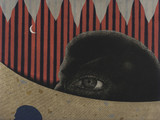Known as "the American Turner," Thomas Moran, Jr., gained fame for his sublime landscapes of the Yellowstone and the Grand Canyon; he was equally famous for his watercolor and oil paintings. Born into a family of artists, Moran began his career around 1856 in Philadelphia as an etcher and in 1858 exhibited his first important painting at the Pennsylvania Academy of the Fine Arts. In 1861 he traveled with his brother Edward (1829-1901) to England expressly to study the paintings of J. M.W. Turner (1775-1851). Moran also traveled throughout England and Scotland, perfecting his use of the English sketching technique.
On his return to the United States he supported himself by drawing magazine illustrations. An article on the Yellowstone in Scribner’s Monthly, which he illustrated, piqued his interest in the uncharted West, and in 1871 he participated in an expedition led by Ferdinand Hayden. His watercolors of the area and the large oil painting The Grand Canyon of the Yellowstone, 1872 (National Museum of American Art, Smithsonian Institution, Washington, D.C.), brought him national recognition. Moran frequently returned to the West, constantly looking for new scenery and expanding his knowledge of the wilderness. In 1872 he briefly visited Yosemite, in 1873 he participated in Major John Powell’s expedition to the Grand Canyon, in 1874 he explored the Colorado area with Hayden’s survey, and in 1879 and again in 1894 he and his brother Peter (1841-1914) explored the Teton Mountains in Wyoming. He toured the West four more times between 1900 and 1910. He also revisited England in 1882 to exhibit his Mountain of the Holy Cross, 1875 (National Cowboy Hall of Fame, Oklahoma City), and made two trips to Venice, another subject for which he became known. In 1883 he visited Mexico and Cuba.
In 1884 he built a studio in East Hampton, New York. The tranquil landscapes of Long Island that he often painted during his later years are quite different from his forceful scenes of the West and prismatic views of Venice. The serene Long Island flatlands also often served as a subject for his etchings, a technique he became preoccupied with during the early 1880s. In 1924 he settled permanently in Santa Barbara, California.
BIBLIOGRAPHY
James Benjamin Wilson, "The Significance of Thomas Moran as an American Landscape Painter," Ph.D. diss., Ohio State University, 1955, with bibliography, catalogue of paintings § Fritiof Fryxell, ed., Thomas Moran: Explorer in Search of Beauty (East Hampton, N.Y.: East Hampton Free Library, 1958), with essays by Fryxell, Ruth B. Moran, A. De Montaigue, and others § Thurman Wilkins, Thomas Moran: Artist of the Mountains (Norman: University of Oklahoma Press, 1966), with descriptive catalogue, bibliography § William H. Truettner, "‘Scenes of Majesty and Enduring Interest’: Thomas Moran Goes West," Art Bulletin 58 (June 1976): 241-59 § Carol Clark, Thomas Moran: Watercolors of the American West (Austin: University of Texas Press for Amon Carter Museum of Western Art, Fort Worth, Tex., 1980), with catalogue raisonné of watercolors, bibliography, checklist of exhibition held at Amon Carter Museum of Western Art, Fort Worth, and others, 1980-81.


